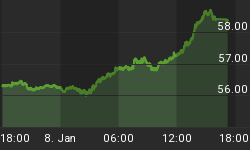U.S. Treasury bonds have traditionally been considered a safe long-term investment - the kind you might include in the "Orphans' Trust" portfolio. However, we believe that may not be the case after 2015. Bond prices should begin a lengthy downward trend relatively soon, and the main question is whether bonds have already found their price high.
Our primary scenario suggests that interest rates may rally some during the early part of 2015 before another test of lows. This is reflected in the TYX chart below. Since 2007, TYX has obeyed the downward-sloping channel. It also has produced a nicely defined price cycle lasting 41 months, and the internal structures of most of the moves have been clear enough to produce accurate Wave59 exhaustion signals (the red and blue numbers that appear at price extremes on our chart). Note also the growing divergence between TYX price and momentum extremes during the last six years.
Our target area for a lasting TYX low is the price range of 19.00-20.75. Based on the price cycle, we would expect to see an interest rate low near the end of 2015 or the beginning of 2016.

The picture we painted for TYX corresponds inversely with our main Elliott wave scenario for 30-year Treasury bonds. Our main count calls for a decline in bond prices during the first half of 2015, followed by an attempt at a new, probably final high late in the year or early next year. However, we also are mindful of an alternate scenario for bonds, in which price has already reached its final high and is at the beginning of a lengthy decline. Our two Elliott wave counts for 30-year Treasury bond futures can be found in a recent post on our website and in an additional article linked from that post.
A similar chart for one of the main ETFs that tracks the long bond shows the present area to be important in terms of resistance, even if it is not necessarily the final price high. The share price for the iShares TLT fund recently tested the top of a channel that has fit well with price extremes since 2010. Note also the exhaustion signal that the Wave59 "nine-five" indicator placed on the January candle.

Regardless of whether the bond high is in or is due later in the year, we expect the process of trend change to be a fairly gradual one. Neither of our scenarios calls for bonds to crash or for interest rates to rise outlandishly in the present decade. However, placing these developments in economic context, it is clear that central banks cannot continue buying treasury issues indefinitely. The run of quantitative easing and similar strategies in the U.S., Europe and Japan has enabled governments to add a nearly unimaginable amount of debt to the global economy, while simultaneously creating a situation where at least some of that debt is unlikely to be repaid. We believe bond markets will begin realizing that constraint soon, if they have not already noticed it, and bond prices should start reflecting diminished expectations for complete repayment.
At TOTM, we are dedicated to showing how traders can make profits consistently even in challenging market conditions. Follow us on Twitter to get timely notices and updates.
















